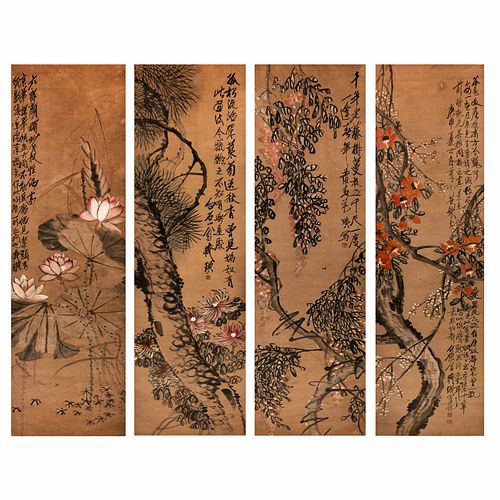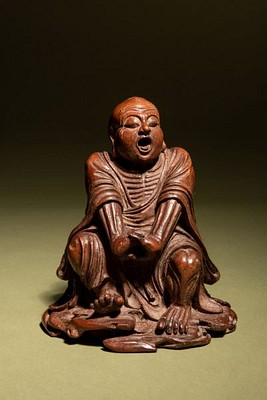Qi Baishi
Lot 29
About Seller
Hindman
1338 West Lake Street
Chicago, IL 60607
United States
Recognized as the Midwest's leading fine art auctioneers, Hindman Auctioneers has built a worldwide reputation based on a full service approach to the auction business tailored to meet the individual needs of our clients. Coming from a variety of educational backgrounds, specialists bring years of e...Read more
Estimate:
$80,000 - $120,000
Absentee vs Live bid
Two ways to bid:
- Leave a max absentee bid and the platform will bid on your behalf up to your maximum bid during the live auction.
- Bid live during the auction and your bids will be submitted real-time to the auctioneer.
Bid Increments
| Price | Bid Increment |
|---|---|
| $0 | $25 |
| $500 | $50 |
| $1,000 | $100 |
| $2,000 | $250 |
| $5,000 | $500 |
| $10,000 | $1,000 |
| $20,000 | $2,500 |
| $50,000 | $5,000 |
| $100,000 | $10,000 |
About Auction
By Hindman
Mar 25, 2021
Set Reminder
2021-03-25 11:00:00
2021-03-25 11:00:00
America/New_York
Bidsquare
Bidsquare : Chinese & Southeast Asian Works of Art
https://www.bidsquare.com/auctions/hindman-auctions/chinese-southeast-asian-works-of-art-6477
Hindman Bidsquare@hindmanauctions.com
Hindman Bidsquare@hindmanauctions.com
- Lot Description
**Please note that online bids will not be accepted for this lot. Please contact the department to arrange for telephone or absentee bidding."" Qi Baishi
(Chinese, 1863-1957)
Flowers of the Four Seasons: Wisteria, Lotus, Chrysanthemum and Prunus
ink and color on paper, four framed scrolls
(1) Lotus in the Rain
signed and inscribed, with one artist seal, Qi Baishi
(2) Pines and Chrysanthum
signed and inscribed, with one artist seal, Baishi weng
(3) Chinese Wisteria
signed and inscribed, with one artist seals, Muren
(4) Camellias and Plum Blossom
signed and dated year Genshen (1920), inscribed, two artist seals, Baishi weng and Muren
1863-1957
1920
1921-23
1936
1908-1952
1989
p214
Average height 69 3/8 x width 18 1/2 in., 176.2 x 47 cm (each image).
Property from the Collection of Hugh W. Hubbard, Sold by the Estate of Lloyd B. and Gladys Hubbard Swift, Bethesda, Maryland
Previously from the Collection of Cao Kun (Ts’ao K’un)
Reverend Dr. Hugh Wells Hubbard (1887-1975) was an American missionary whose station in China largely covered the first half of the twentieth century. Born in Turkey to missionary parents, Reverend Hubbard was initially reluctant to follow in his family’s footsteps, but found a calling in his first missions, and subsequently dedicated his life’s work to service in China across many fields.
Rev. Hubbard arrived in China in 1908 to teach English and athletics under the auspices of the YMCA. After meeting and marrying his wife, Mabel Ellis, he became ordained as a minister within the Congregational Church, and continued his missionary work under the American Board. He devoted many of his efforts to promoting literacy and rural development with the guidance of Dr. Y.C. James “Jimmy” Yen. Rev. Hubbard believed that the goals of his mission were to serve as a friendly and caring companion to all he encountered, which he achieved in part through these efforts. Inspired by the power of visual arts, he undertook a project to develop educational filmstrips in his own basement for use in his teaching. This work continued in his later collaborations with renowned animator Norman Maclaren for UNESCO.
In addition to his evangelical work, Rev. Hubbard also cultivated strong interests in ornithology and philately. In 1938, Reverend Hubbard collaborated with Dr. George Wilder to publish Birds of Northeastern China. Hubbard was a skilled hunter with a keen eye, who employed his skills both to collect specimens for institutions in the United States, including the Field Museum and Museum of National History; and to amuse children with whom he was held during their wartime internment at Weixian. After returning to the United States, he published The Handbook of Early Chinese Communist Stamps (1928–1938).
Rev. Hubbard’s interest in Chinese art and culture was piqued by early elective courses taken alongside his language instruction in Beijing. Throughout his tenure in China, he enjoyed diversions to curio shops and antique streets. He would visit the Palace Museum whenever in Beijing to cultivate his interest in painting, but made his purchases quite selectively. The present lot is an example of one such purchase. Rev. Hubbard acquired the paintings from the Baoding mansion of Cao Kun, a former warlord and president of the Republic of China, who was closely connected to the artist. They were removed from their mounting as a screen, and fortuitously brought by Rev. Hubbard to the United States while on furlough in 1936. They remained in his care until 1967, when he bequeathed them to his daughter Gladys Hubbard Swift, who had also served as a missionary to China.
傳教士胡本德(1887-1975)家藏齊白石為曹錕作《四時花卉》四屏
中美交流史上,沒有一個話題可以繞開傳教士。羅元旭《東成西就》云,从十九世纪中葉开始的一百年,是基督教在中國傳入、興起、鼎盛到衰敗的一百年,從這個角度品評現代化歷程,帶出的是不平凡的中國歷史。落脚到藝術收藏這小小領域,傳教士以其特殊的社會地位與職業特性,往往于無意間成爲早期中國藝術品的傳送帶、中轉站。
稱之爲“無意“,是因爲像許多職業一樣,傳教士之所以成爲傳教士,有時是無奈的選擇。譬如本拍品的前藏家胡本德,儘管生於傳教士家庭,卻對既定的前途生厭,可是經濟壓力之下,還是走上了父輩的道路。1908年他以天津基督教青年會體育教練的身份赴華,是以今天我們在華語網站搜索“胡本德”,往往發現他的主要貢獻是最早將籃球介紹到中國。
教會的待遇十分優厚,胡原本打算賺夠錢就回國,然而不久後結識了心儀的女孩——美部會教士葉美伯,在葉的潛移默化之下,迷茫的胡確定了前路,1912年他們回國成婚,在奧伯林神學院進修傳教士課程后,重返中國。
此後三十年,胡本德以公理會教士的身份在華北推行平民教育:他向他們教英文,也向他們學中文。他使用晏陽初編纂的《千字課》教農民識字,十年間有五千余人受益。1924年秋在他火車上初遇晏陽初,晏對胡取得的成果大為驚訝,不僅跟隨他挨村走訪汲取經驗,還邀請他參加國民政府的鄉村教育試點項目,負責定縣試驗縣。
在華期間,胡本德還發展了兩項新愛好:其一是觀鳥,因每年夏天都會到北戴河避暑,而北戴河至今仍是觀鳥聖地。1922年他撰寫了《直隸鳥類名錄》,1938年和同樣是鳥類愛好者的傳教士萬卓志合編了《東北鳥學》,這兩本專著至今仍是華北鳥類研究的始祖。後來華北淪陷,胡本德一家被抓進日軍集中營,在營中的兩年他也沒有荒廢,除了繼續辦學授課,還製作了大量標本以供研究。胡本德的另一愛好是集郵,而且是“紅色郵票”最早的收藏者之一。這源於他多次協助地下黨籌措藥品的經歷,與他接洽的不是別人,正是大名鼎鼎的白求恩。
抗戰勝利后,胡本德留在重慶擔任聯合國教科文組織駐華代表,主持四川北碚影音教育所。國民黨的迅速垮臺使他措手不及,儘管後來回到北方與家人團聚,但由於朝鮮戰爭爆發,被迫軟禁家中,直到1952年才重返美國。中美關係破冰前,尼克松曾向他咨詢,胡本德對曰“中國人好面子,只要把面子給足了,事情就好辦了”。在他的晚年,哥倫比亞大學中國近代史研究組有感於他的經歷,為其錄製并整理了回憶錄,如今這些資料存放在耶魯大學。
按回憶錄記載,二十年代初期他在保定傳教,得以接觸直系軍閥,此四條屏就是在曹錕府上購入的,經手人是曹的心腹李彥青。蓋當時第一次直奉戰爭直系獲勝,曹已有進京之野心,出任大總統的計劃通過駐華公使的運作,獲得了美國支持,李彥青爲他處理保定府中不必要的資產之際,見美國來的傳教士胡本德喜歡,就把四條屏送人情賣給了他。
齊白石完成此作是在1920-21年,時年56嵗,經同鄉夏午詒介紹認識曹錕。大概是同出于草根之故,脾性相投,曹常請齊來保定小住。作畫之餘,還煩他刻過“直魯豫巡閱使”、“樂壽老人”等章。直到1924年曹錕被逼下野並遭軟禁,才慢慢斷了聯係。這一段交往,對齊白石生平有所瞭解的藏家皆知,是無可懷疑的事。胡本德1936年返美休假時將此作帶回,恰好避過了日軍的戰火以及集中營生涯的厄運。1975年胡本德下世,遺產由女兒繼承,幾年前女兒去世留給孫輩,拍品就是這樣徵集而來的,靜待下一任藏家傳承。Additional images available upon request. Please contact Asian@HindmanAuctions.com for a complete condition report.Condition
- Shipping Info
-
Please refer to https://hindmanauctions.com/shipping-packing
-
- Buyer's Premium



 EUR
EUR CAD
CAD AUD
AUD GBP
GBP MXN
MXN HKD
HKD CNY
CNY MYR
MYR SEK
SEK SGD
SGD CHF
CHF THB
THB





























